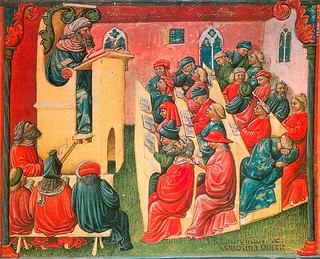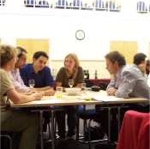|
Conversational talks and conferences
In a traditional conference (or an internal organisational meeting), although there are often interactive sessions, the dominant style of presentation is the PowerPoint talk. The speaker talks for a period of time, supported by a PowerPoint presentation and then 5 to 10 minutes is allowed for questions from the audience. In a conversational conference/meeting however, the dominant style of talk is the Conversational talk where time is allowed for the The participants are normally seated at small round tables, 4 - 5 people per table but the format still works well with larger tables and even in lecture halls or in banked auditoriums though the smaller grouping is more conducive to conversation. The participants then quietly reflect on the talk for a minute or two individually, before discussing the talk and the question in small groups before going into a traditional Q&A. Even, in a lecture theatre it is not too difficult for people to form groups of 3 or 4 by turning to their neighbours. The conversation is seen as more valuable than the Q&A and usually 10 - 15 minutes is allowed for the conversation and only 5 - 10 minutes for the Q&A. This conversational format is intended to create an informal, relaxed atmosphere in which the conference participants engage with the topic; get to know each other; learn from each other; and build relationships. One of the attractions of this style of talk for both the speaker and the conference/meeting organiser is that it involves minimal change as quite simply just a short period of time for conversation is inserted between the talk and the Q&A. This time can be taken from the speaker's talk or additional time can be allowed by the conference/meeting organiser. One of the nice thingsabout the "conversational talk" is that any speaker can chose to adopt this format. They do not need pemission from the organiser. Its worth forewarnng the chairperson but apart from that - just do it. David Gurteen, Gurteen Knowledge |
The Conversational Conference by David Gurteen
Over recent years, I have attended, spoken at, or chaired many conferences and apart from a few notable exceptions I have been appalled at the design of the events.

Notice, two people are asleep, several are engaged in conversaton and one in the back row even seems to be texting on his mobile phone!
Things have not changed much in over 600 years!
Although, occasionally there are mini-workshops and other interactive sessions, the dominant format is the deathly "PowerPoint presentation".
These presentations normally take the form of a talk followed by a Q&A session. Typically, each talk is scheduled to last for 30 minutes followed by 10 minutes for Q&A.
Sometimes, the torture lasts longer with 1 hour sleep-inducing talks with say 50 minutes for the talk plus10 minutes Q&A.
Speakers are often not sufficiently briefed or disciplined; they have far too many Powerpoint slides and a weak chairperson lets them run over time.
This is exacerbated by the fact that there is little or no slack in the schedule and insufficient time is allowed for coffee breaks and for lunch and no time has been built into the day for reflection, conversation or networking.
This results in the erosion of the time for coffee breaks and lunch. It is "serial death by PowerPoint!".
The victims (the audience) are often seated in neat theatre style rows, reminiscent of the worst of class room teaching. This style of seating is deliberately designed to minimise interaction between people. Even when seated at large round tables of 8 people or more, it is still difficult to engage in conversation given the separation distance. I have a rule-of-thumb that says you need to be in touching distance of a person to have a good conversation with them.
And then In some cultures and in more formal conferences often no time is even allowed for questions. Keynote speakers arrive moments before they are due to talk, deliver their speech with no Q&A and rapidly depart after a brief "feting" y a few membersof the audience.
What's worse is that so many of conferences are about education, learning or knowledge management - no one is "walking the talk"!

Show me a Professor of Education ... who lectures, and I'll show you a hypocrite who doesn't read the research.
Credit: Don't Lecture me by Donald Clark
But there is a simple improvement that can be made. It is to make the talks conversational. This approach is far from perfect and does not make a conference as interactive and engaging as it might be but it is a small step in that right direction that is of low cost and minimal impact on the conference.
In a conversational conference, the dominant style of talk is the conversational talk. Each speaker presents for a period of time - usually 20 to 30 minutes - and concludes their talk with a question to the audience.
The audience is normally seated at small round tables, 4 - 5 people per table but the format will work with larger tables and even in lecture halls or in banked auditoriums though the smaller grouping is far more conducive to conversation.
The audience then quietly reflects on the talk for a minute or two individually, before discussing the speaker's talk and the question in small groups before going into a traditional Q&A. In a lecture theatre it is not too difficult for people to form groups of 3 or 4 by turning to their neighbours.
The conversation is seen as more valuable than the Q&A and usually 10 - 15 minutes is allowed for the conversation and only 5 - 10 minutes for the Q&A.
This format is not intended to fully replace all PowerPoint talks. Keynote presentations delivered by a professional engaging speaker with provocative content are still effective and can be run in the traditional manner. TED Talks are a good example.
The mind is not a vessel to be filled but a fire to be kindled.
This video although taken at one of my Knowledge Cafe's and not at a conference
clearly demonstrates the degree of engagement and interaction
that is generated by a talk followed by a powerful question.
clearly demonstrates the degree of engagement and interaction
that is generated by a talk followed by a powerful question.
|
Gurteen Knowledge Cafe: SMARTlab
The University of East London |
Knowledge Cafés as KM Tools
KM India 2010 |
Gurteen Knowledge Cafe
KMPAP 2006 in Hong Kong |
|
Introduction to the Knowledge Cafe Greenwich 2006
|
Knowledge Management Egypt
Cairo 2010 |
The Gurteen Knowledge Cafe Amsterdam 2009
|
The concept of the Conversational Conference is an adaptation of the Gurteen Knowledge Cafe.
You can learn more about the Knowledge Cafe in the videos above.
You can learn more about the Knowledge Cafe in the videos above.
|
If you are interested in Knowledge Management, the
Knowledge Café
or the role of conversation in organizational life then you my be interested in this online book I am writing on
Conversational Leadership
|


